
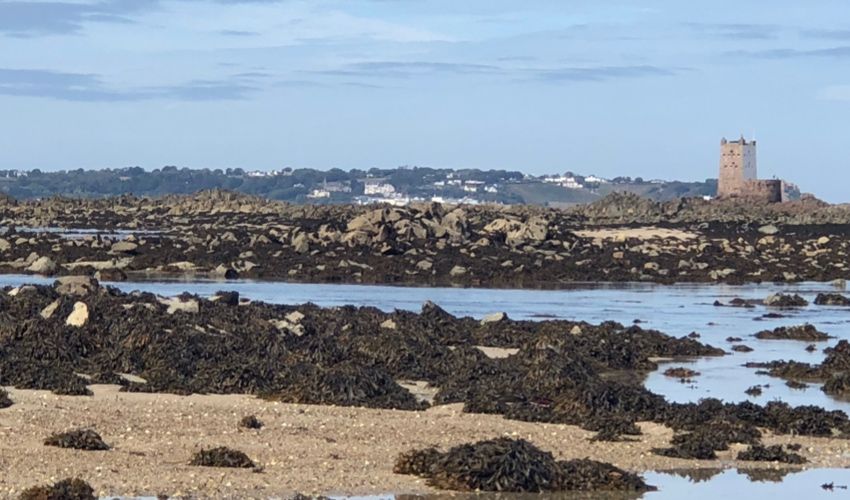

New scientific research carried out around Jersey is providing irrefutable proof that sea temperatures around the island are rising at a rapid rate, putting long-established species under threat.
Small temperature loggers were placed around the island – both in the intertidal zone and further out to sea – just before lockdown in March 2020. Now, two-a-half years later, that data can now be analysed.
Express explores what it tells us...
The initial findings have provided some fascinating insights: that the temperature at the sea surface is the same as on the seabed around Jersey, and that the temperature recorded at the Harbour is the same around the island’s territorial waters.
Combined with satellite data, the research also shows that Jersey is oceanographically isolated from the rest of the English Channel, including Guernsey and Alderney, and this may serve to enhance rising temperatures.
It appears that water enters the Bay of Granville from the south and is then trapped in the seas around Jersey, Chausey, Mont St. Michel and across to St. Brieuc on the north Breton coast.
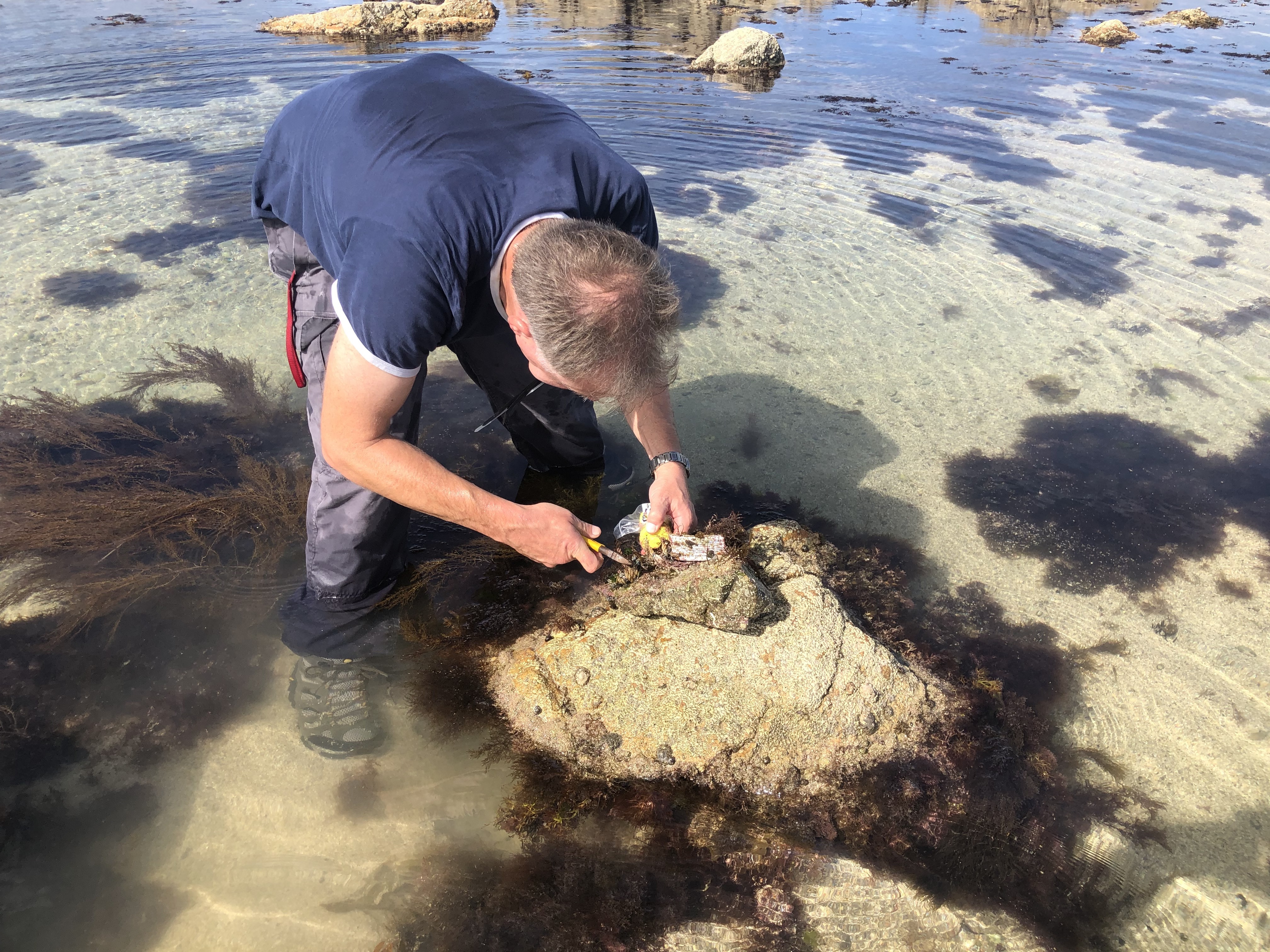
Pictured: Dr Paul Chambers changes a sea temperature logger attached to a rock in a pool in the south-east inter-tidal zone.
Swirling around the islands and reefs, the water can remain in the Bay for up to a year, warming up, before it escapes back into the Channel and Atlantic.
Flying west of the island, it is not uncommon to see a clear line in the sea running south-west to north-east between Jersey and Guernsey, marking the different temperatures.
Commenting on the data, the Government’s Head of Marine Resources, Dr Paul Chambers, said: “The data seems to confirm what we’ve suspected for some time: namely that there has been a marked rise in sea temperatures over the past four decades and that this is exaggerated during the autumn and winter months.
“The results are preliminary and need to be reviewed but we have enough data to start seeing trends.”
The loggers are attached to rocks and buoys around the island, off its reefs and as far as Guernsey and Alderney. They show a wide sea temperature variation across the islands which, inter-tidally, can range from 2°C to 27°C, over the year.
Offshore, it varies between 7°C and 20°C.
With the data at the Harbour acting as an accurate proxy for temperatures on the seabed, it is clear that Jersey’s waters are warming, although the arrival of new species is nature’s way of providing its own evidence.
These include Couch’s Bream, Black-faced Blenny, Leopard-spotted Goby and Giant Goby.

Pictured: The Government's Head of Marine Resources, Dr Paul Chambers, at the Karame Beacon off La Rocque, which is only accessible by foot on the lowest of spring tides.
New arrivals since the 1990s includes various species of jack and bream, such as Amberjack, Bogue and Pandora, together with Atlantic Saury, Bonito and Spotted Seabass.
Species at or near the southern edge of their range include the commercially-caught chancre crab and whelk. Conversely, spider crab is abundant, possibly due to the warmer seas.
Brown crab is also at the southern edge of its range but the collapse in its numbers is predominately linked to disease.
Non-native species are also moving up from the south, including a rare sea slug recently spotted at Les Ecréhous.
The St. Helier sea temperature dataset starts in 1933 and runs through today, with a break for the Occupation.
It suggests there has been a rise of around 1.2°C overall, much of it in the autumn and winter months.
The summer temperature has only risen very slightly, by 0.3°C, whereas the winter temperature has increased by at least 1.6°C.
Most of that rise has happened since the late 1980s.
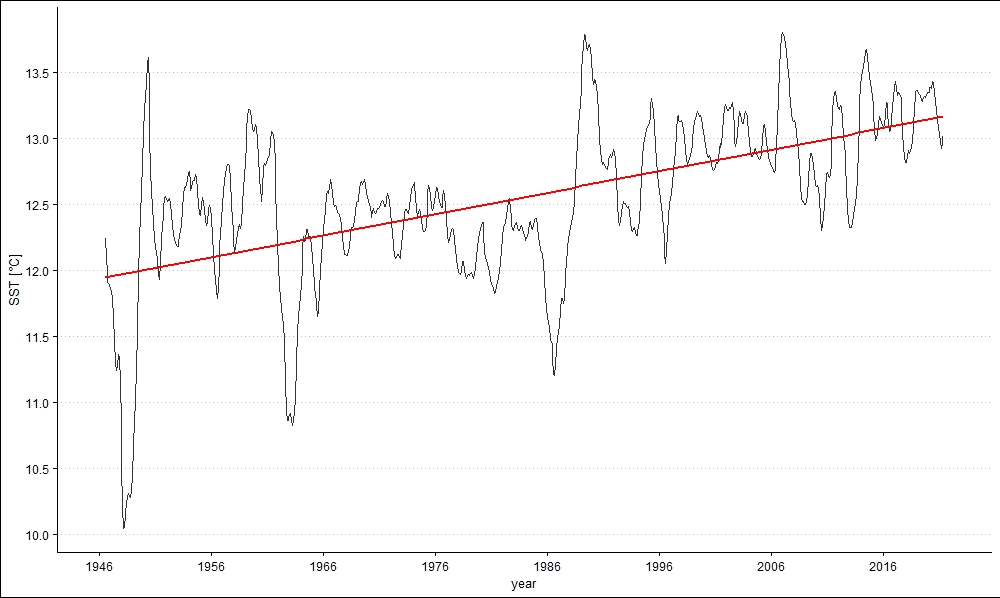
Pictured: A graph showing how the average yearly sea temperature recorded at the Harbour has risen over the past 75 years (Credit: Jersey Met)
Dr Chambers said: “The significance of this is that warmer winters will allow what used to be summer migrants to remain all year round and, conversely, may impact species, such as chancre, whose breed cycle requires a cold phase during the year.”
One logger retrieved and replaced by Dr Chambers recently offers fascinating insight into temperature change in rockpools, an important ecosystem for many species.
Temperatures in some pools have been recorded as high as 27°C, which can be more than 8°C higher than the corresponding sea temperature.
“If increased summer air temperatures, and heatwaves, are to be a regular occurrence then this could have an effect on some of the species, and therefore also the habitat structure, within our rock pools,” said Dr Chambers.
“Temperature plays an important role in the biology and behaviour of many marine creatures and will govern their rate of growth, breeding patterns and, for some, timing for annual events such as migrations.
“Many species will have a temperature above which they either cannot survive or which will start to disrupt aspects of their biology or reproduction.
“Most larvae development is temperature sensitive with warmer water shortening the time that they spend floating in the water column before settling. Temperature also plays a role in disease and the arrival of new species which may outcompete local ones.”
He added: “There will always have been a difference between the temperature of the open sea and within rock pools.
“However, the rising sea temperature trend - by over 1°C since the early 1980s - and warmer summers has the potential to change the daily and seasonal temperature profile of our rock pools.
“Quite how this could impact local seashore life is still being investigated but it begs many questions."
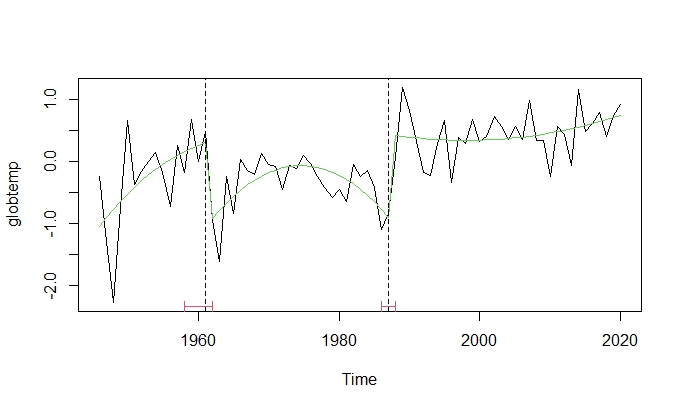
Pictured: A graph showing 'breakpoints' in rising sea temperatures at the Harbour. A breakpoint marks a statistically significant change. Analysis has identified just two breakpoints since 1946 – one in the early 1960s and the other the late 1980s. Of these, the late 80s is the most statistically significant by far and can be seen in other datasets across the English Channel.
He explained: “Let’s say, hypothetically, that there is a species - species ‘X’ - which can be found in rock pools and also the shallow marine environment, which is true of many of our species.
“Species X will spawn once the water temperature reaches around 18°C which at sea happens at the end of July/August. However, in our rock pools, 18°C is reached in early May.
“Does this mean that species X living in rock pools will spawn several weeks earlier than those living at sea?
“If so, then what happens to the eggs/larvae of species X when at high water the rock pool is engulfed by the sea and the temperature drops by several degrees?
“More worryingly, what if species X has a maximum temperature tolerance of 25°C after which it cannot survive locally?
“This temperature has been reached in rock pools during both the summers that the loggers have been operating.”
Dr Chambers added: “Marine Resources and Jersey Met are only at the start of our research into local sea temperatures, but early results suggest that it is something that we should be taking seriously.
“This is an embryonic project which is looking at several different research areas including modelling sea temperature across Jersey’s waters, the relationship between sea temperature and the behaviour of some of our key commercial species as well as important habitats such as seagrass and rock pools.”
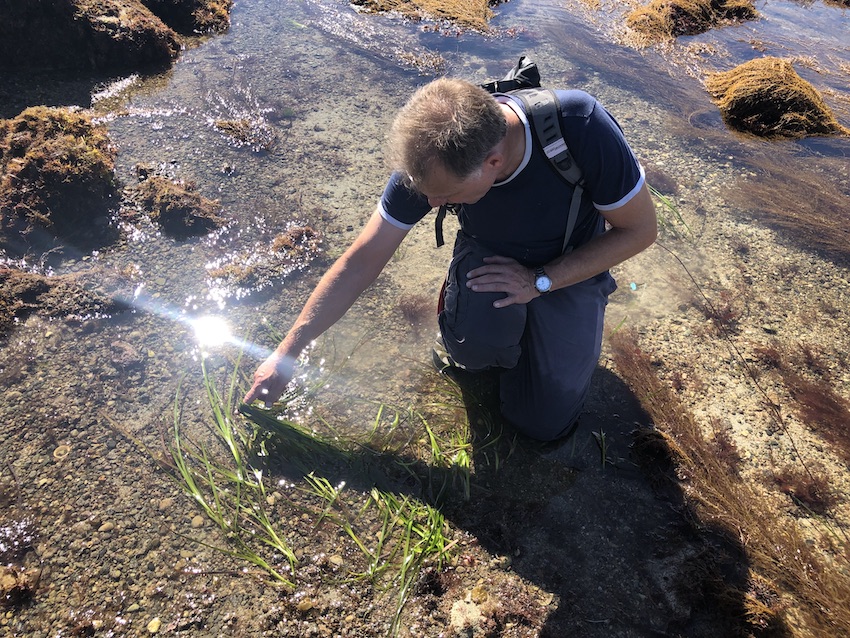
Pictured: Areas of sea grass have doubled off the south-east corner in the past 15 years. Rising sea temperatures could be a driver but no research has yet been carried out to find out the reason why.
He added: “The temperature loggers are deployed and retrieved during routine patrol and other business as usual work and so are an efficient way of gathering data. It is hoped that a summary of the initial findings will be available in a report next year.”
Climate data collected in Jersey show that the annual average air temperature is 1.2°C higher than it was 100 years ago.
Most of that rise has been in the past 40 years, providing unequivocal proof, say the Met Office, that air and sea temperature rises are being exaggerated by human activity, such as the burning of fossil fuels.
Earlier this year, the States Assembly committed to introduce measures to achieve net-zero carbon emissions by 2050, which includes banning the registration of petrol and diesel-powered vehicles from 2030.
Comments
Comments on this story express the views of the commentator only, not Bailiwick Publishing. We are unable to guarantee the accuracy of any of those comments.